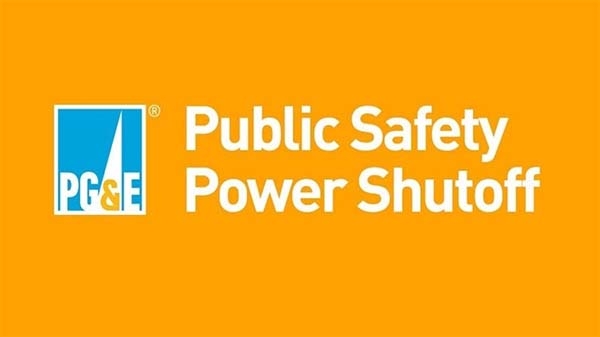
An estimated 21,000 customers who might be affected by the Public Safety Power Shutoff are receiving the initial notifications today–two days ahead of the potential event
Fewer than 1 percent of PG&E customers could be affected by shutoff
SAN FRANCISCO, Calif. — This afternoon, Pacific Gas and Electric Company (PG&E) notified customers in portions of three Northern Sierra and North Valley counties about a potential Public Safety Power Shutoff (PSPS) starting Saturday evening. Hot and dry conditions combined with expected high wind gusts pose an increased risk for damage to the electric system that has the potential to ignite fires in areas with dry vegetation.
High fire-risk conditions are expected to arrive Saturday evening, continue through Sunday evening and subside Monday morning. PG&E will then inspect the de-energized lines to ensure they were not damaged during the wind event. PG&E will safely restore power in stages as quickly as possible, with the goal of restoring most customers within 12 daylight hours, based on once the weather “all clear” is provided.
While there is still uncertainty regarding the strength and timing of this weather system, the shutoff is currently expected to impact approximately 21,000 customers in portions of Butte, Plumas and Yuba counties. This weather event will be localized to the Sierra Foothills, so customers in the Bay Area and southern parts of PG&E’s service area will not be impacted.
Potential Public Safety Power Shutoff: What People Should Know
The potential PSPS event is still at least 48 hours away. PG&E’s in-house meteorologists as well as its Wildfire Safety Operations Center and Emergency Operations Center will continue to monitor conditions, and additional customer notifications will be issued as we move closer to the potential event.
Customer notifications—via text, email and automated phone call—began late this afternoon. Customers enrolled in the company’s Medical Baseline program who do not verify that they have received these important safety communications will be individually visited by a PG&E employee with a knock on their door when possible. A primary focus will be given to customers who rely on electricity for critical life-sustaining equipment.
Why PG&E Calls a PSPS Event
Due to forecasted extreme weather conditions, PG&E is considering proactively turning off power for safety. Windy conditions, like those being forecast, increase the potential for damage and hazards to the electric infrastructure, which could cause sparks if lines are energized. These conditions also increase the potential for rapid fire spread.
State officials classify more than half of PG&E’s 70,000-square-mile service area in Northern and Central California as having a high fire threat, given dry grasses and the high volume of dead and dying trees. The state’s high-risk areas have tripled in size in seven years.
No single factor drives a PSPS, as each situation is unique. PG&E carefully reviews a combination of many criteria when determining if power should be turned off for safety. These factors generally include, but are not limited to:
- Low humidity levels, generally 20 percent and below
- Forecasted sustained winds generally above 25 mph and wind gusts in excess of approximately 45 mph, depending on location and site-specific conditions such as temperature, terrain and local climate
- A Red Flag Warning declared by the National Weather Service
- Condition of dry fuel on the ground and live vegetation (moisture content)
- On-the-ground, real-time observations from PG&E’s Wildfire Safety Operations Center and observations from PG&E field crews
New for 2020: Improved Watch and Warning Notifications
In response to customer feedback requesting more information as soon as possible to ensure they have time to prepare for and plan in advance of a potential PSPS event, PG&E will provide improved Watch and Warning notifications this year.
Whenever possible, an initial Watch notification will be sent two days in advance of a potential PSPS event. This is what is being sent to customers today. One day before the potential PSPS event, an additional Watch notification will go out, notifying customers of the possibility of a PSPS event in their area based on forecasted conditions.
A PSPS Watch will be upgraded to a Warning when forecasted conditions show that a safety shutoff will be needed. Whenever possible, Warning notifications will be sent approximately four to 12 hours in advance of the power being shut off.
Both Watch and Warning notifications are directly tied to the weather forecast, which can change rapidly.
As an example of how notifications have been improved for 2020, customers will see the date and time when power is estimated to be shut off as well as the estimated time when their power will be restored, all provided two days before the power goes out. Last year, the estimated time of restoration was not provided until the power had been turned off.
Here’s Where to Go to Learn More
- PG&E’s emergency website (www.pge.com/pspsupdates) is now available in 13 languages. Currently, the website is available in English, Spanish, Chinese, Tagalog, Russian, Vietnamese, Korean, Farsi, Arabic, Hmong, Khmer, Punjabi and Japanese. Customers will have the opportunity to choose their language of preference for viewing the information when visiting the website.
- Customers are encouraged to update their contact information and indicate their preferred language for notifications by visiting www.pge.com/mywildfirealerts or by calling 1-800-742-5000, where in-language support is available.
- Tenants and non-account holders can sign up to receive PSPS ZIP Code Alerts for any area where you do not have a PG&E account by visiting www.pge.com/pspszipcodealerts.
- PG&E has launched a new tool at its online Safety Action Center (www.safetyactioncenter.pge.com) to help customers prepare. By using the “Make Your Own Emergency Plan” tool and answering a few short questions, visitors to the website can compile and organize the important information needed for a personalized family emergency plan. This includes phone numbers, escape routes and a family meeting location if an evacuation is necessary.
Smaller, Shorter, Smarter PSPS events
PG&E is learning from past PSPS events, and this year will be making events smaller in size, shorter in length and smarter for customers.
- Smaller in Size: This year, PG&E expects to cut restoration times in half compared to 2019, restoring power to nearly all customers within 12 daylight hours after severe weather has passed, by:
- Installing approximately 600 devices that limit the size of outages so fewer communities are without power.
- Installing microgrids that use generators to keep the electricity on.
- Placing lines underground in targeted locations.
- Using better weather monitoring technology and installing new weather stations.
- Shorter in Length: To make events shorter, PG&E expects to restore customers twice as fast by:
- Expanding its helicopter fleet and using new airplanes with infrared equipment to inspect at night.
- Deploying more PG&E and contractor crews to inspect equipment and restore service.
- Smarter for Customers: In order to make events smarter for customers, PG&E is:
- Providing more information and resources by improving the website bandwidth and customer notifications, opening Community Resource Centers and working with local agencies and critical service providers.
- Providing more assistance before, during and after a PSPS event by working with community-based organizations to support customers with medical needs making it easier for eligible customers to join and stay in the Medical Baseline program.
Earlier this month, due to better weather technology and mitigation efforts such as sectionalizing devices and temporary generation, the Sept. 7-10 PSPS event affected approximately 50% fewer customers than a comparable event would have in 2019.
Community Resource Centers Reflect COVID-Safety Protocols
PG&E will open Community Resource Centers (CRCs) in every county where a PSPS occurs. The sole purpose of a PSPS is to reduce the risk of major wildfires during severe weather. While a PSPS is an important wildfire safety tool, PG&E understands that losing power disrupts lives, especially for customers sheltering-at-home in response to COVID-19. These temporary CRCs will be open to customers when power is out at their homes and will provide ADA-accessible restrooms and hand-washing stations; medical-equipment charging; Wi-Fi; bottled water; and non-perishable snacks.
In response to the COVID-19 pandemic, all CRCs will follow important health and safety protocols including:
- Facial coverings and maintaining a physical distance of at least six feet from those who are not part of the same household will be required at all CRCs.
- Temperature checks will be administered before entering CRCs that are located indoors.
- CRC staff will be trained in COVID-19 precautions and will regularly sanitize surfaces and use Plexiglass barriers at check-in.
- All CRCs will follow county and state requirements regarding COVID-19, including limits on the number of customers permitted indoors at any time.
Besides these health protocols, customers visiting a CRC in 2020 will experience further changes, including a different look and feel. In addition to using existing indoor facilities, PG&E is planning to open CRCs at outdoor, open-air sites in some locations and use large commercial vans as CRCs in other locations. The CRC to be used will depend on a number of factors, including input from local and tribal leaders. Supplies also will be handed out in grab-and-go bags at outdoor CRCs so most customers can be on their way quickly.
How customers can prepare for a PSPS
As part of PSPS preparedness efforts, PG&E suggests customers:
- Plan for medical needs like medications that require refrigeration or devices that need power.
- Identify backup charging methods for phones and keep hard copies of emergency numbers.
- Build or restock your emergency kit with flashlights, fresh batteries, first aid supplies and cash.
- Keep in mind family members who are elderly, younger children and pets.
About PG&E
Pacific Gas and Electric Company, a subsidiary of PG&E Corporation (NYSE:PCG), is one of the largest combined natural gas and electric energy companies in the United States. Based in San Francisco, with more than 20,000 employees, the company delivers some of the nation’s cleanest energy to 16 million people in Northern and Central California. For more information, visit pge.com and pge.com/news.






